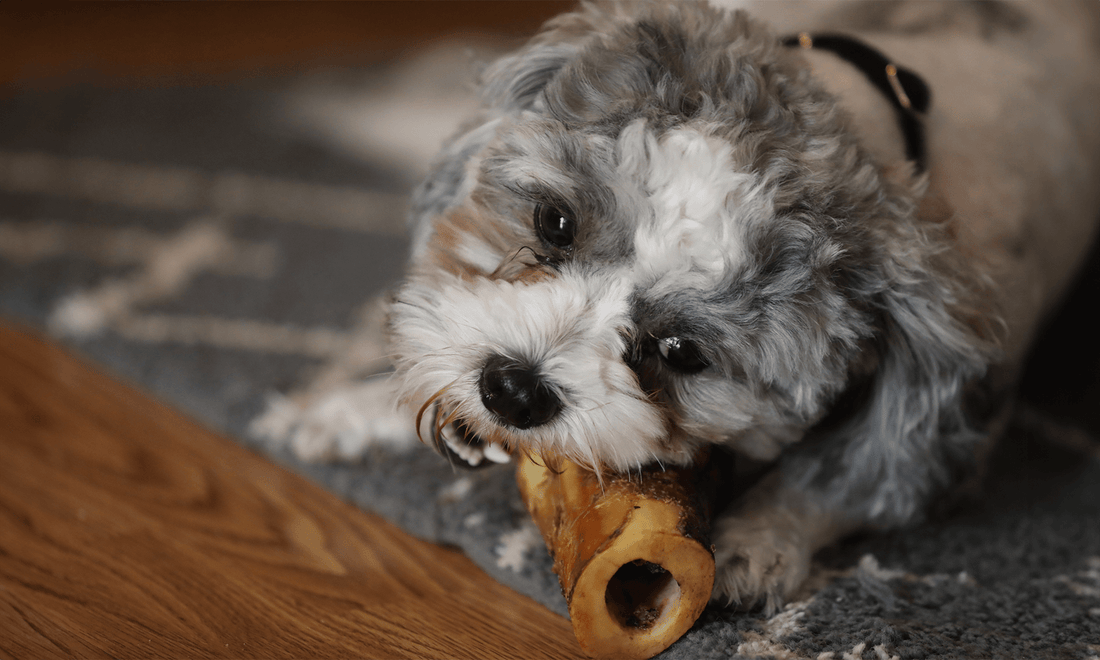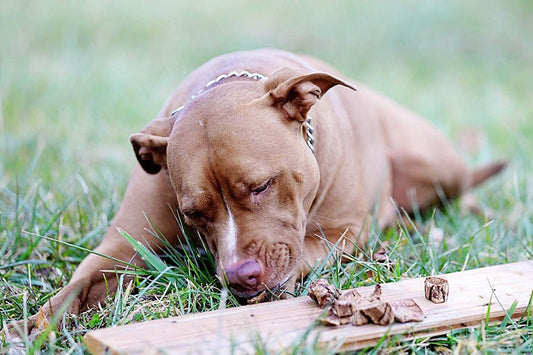
Biting Off More Than They Can Chew: Dog Bones and Dental Damage
Dawn Miller Oct 11, 20245 Minute ReadOver the summer, I went with my two kids to our family dentist while they were home from college. As we were sitting in the waiting room, I could tell they were feeling pretty confident about their dental health. No cavities today; just a routine cleaning. Fingers crossed.
We've put a lot of emphasis on dental health in our home since they were young. Naturally, this has extended to the dental health of my furry kids, 3 energetic dogs, including one who is getting up in years.
The truth is dog bones are often marketed as the best chews for dogs' teeth. But they can sometimes do more harm than good. Have you ever heard that sound of a bone cracking under your dog’s powerful jaws and thought, "Wow, I hope that's not their tooth?"
Let’s get real! While dogs love a good chew session, there are risks. Some may not be the best chews for dogs' teeth. Sometimes, they bite off more than they can chew. I’ve learned a lot about balancing the fun of chewing with the safety of their pearly whites.
How Chewing Can Go So Wrong
I'll say it, for the record. Dog bones can offer a lot of benefits, including reducing plaque and promoting gum health. But, if I do a quick cost-benefit analysis, some bones have a higher risk than reward. Hard bones, including some bone marrow bones for dogs that my lab mix, Bruno, loves can be too tough for teeth. Fractures, chips and worsening dental health over time could result if I'm not careful with what I give him.
As I sat there waiting for my oldest to return for the dentist's chair, I couldn't help but think about what makes the best bones for dogs. It's certainly not going to be something that damages teeth.
It will be a dog bone that delivers all the benefits of marrow bones with less risk of a dental emergency.
What to Look for in a Good Dental Chew
So, what makes for the best chews for dogs' teeth? It’s not just about how long they last but also how safe they are. Over time, I’ve learned a few tips to make sure my 3 pups are enjoying bones safely.
Size Matters
Always choose a bone that’s big enough so they can’t swallow it whole. This is critical because choking is arguably worse than breaking a tooth. But the bone also should not be so big that they hurt their jaw trying to get a good grip on it.
Dogs need a healthy jaw as much as they need teeth to eat without pain. Medium dogs like my terrier Pixie shouldn't get a massive bone for large dogs. Instead, they need an appropriately sized bone. Pixie likes the Dynamo bone.
And for the smallest of dogs and puppies, tiny bones for their itty bitty jaws.
Additionally, "bones" with a bit of give, like softer chew bones for dogs, can be great for cleaning teeth while reducing the risk of fractures. You could try beef trachea chew if you're already concerned about your dog's dental health.
Density is Key
Bones can be too hard. But they can't be too soft or pieced and might break off and cause choking hazards. This comes down to dog bone density.
The best bones for dogs are the right type of bone, and they are prepared to have the right density.
Examples of dog bones that are too soft include dinner bones, used bone broth bones, overcooked bones, chicken, turkey, and hambone. While these don't sound like they could hurt teeth, the truth is that the softness can allow teeth to sink into the bone, which could cause an otherwise healthy tooth to become loose and eventually fall out.
On the other hand, completely raw bones will be too hard. These can break teeth outright.
The best bones of ideal density include beef marrow bones that have been cooked using a slow and low-heat cooking process for the right amount of time to achieve the perfect density. Professionally prepared marrow bones maximize nutrition and bone density while killing off the pathogens on raw bones.
Natural Ingredients
Make sure you’re picking something that doesn’t have artificial flavors or colors. I always go for the natural options for Bruno and Pixie. Some dog bone options out there, like rawhide, use potentially dangerous chemicals to dry the animal skin and shape it into bone.
If something isn't good to ingest, then it's probably not ideal for dental health either.
No Sugar
I've raised my kids to be aware of the potential damage of eating candy and sugary drinks and not brushing their teeth regularly. The same goes for dogs. Did you know that some fake dog bone companies put sugar into the recipe because the bone doesn't taste good?
This is not an issue with a meaty marrow bone. It's all flavor, with sweet naturally-occurring bone marrow your dog can lick out as they chew. That marrow becomes a reward as they work on gnawing the bone. It's so nutritious.
My dogs don't need dog bones with added sugar to get their dopamine spikes.
But beyond ingredients, size, and density, I need to address how I give my dogs their bones safely to maximize the dental health benefits while reducing risk.
The Risk of Over-Chewing
Real marrow bones are great! You'll hear me say it again and again. They have lots of protein and healthy fats. They relieve boredom and help dogs clean the plaque off of their teeth like a toothbrush.
To learn more about the health benefits of marrow bones check out my recent article over here.
But.
There is such a thing as too much chewing. Dogs can get obsessive with their bones, leading to dental wear. Some breeds, especially the bigger chewers, are at higher risk of dental injuries like worn-down teeth or even root exposure. That’s why I make sure my dogs don’t go overboard.
My local vet once told me that dental issues in dogs often go unnoticed until they’re in pain. And by then, it’s usually too late. So, she told me to limit their chewing sessions and give them regular vet checkups to keep an eye on their teeth.
And this advice checks out with the American Kennel Club's advice to not let treats be more than 10% of a dog's diet.
To achieve this, we have 3 chew time sessions a week for 20 minutes. This gives my pups just enough time to get some marrow and enjoy the dental and mental health benefits. At the same time, cutting it short reduces the chances of obsessive gnawing, which can lead to dental damage.
This also makes our dog bones last longer, as good dental chews for dogs should. When the marrow is gone after several chew sessions, I even replace it with some nutritious marrow refill ideas in this bone refill recipe guide.
The Best Chews for Dogs Teeth
Let's sum this up. The best chews for dogs' teeth are real beef marrow bones that are the right size for your dog and properly prepared to achieve the right density. See the bones Pixie and Bruno love here.Available On:





